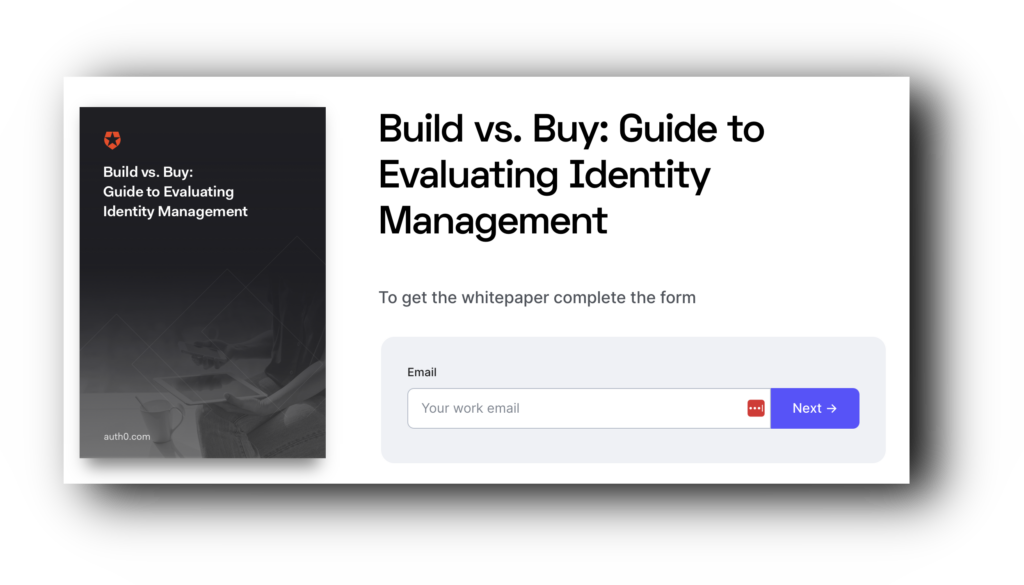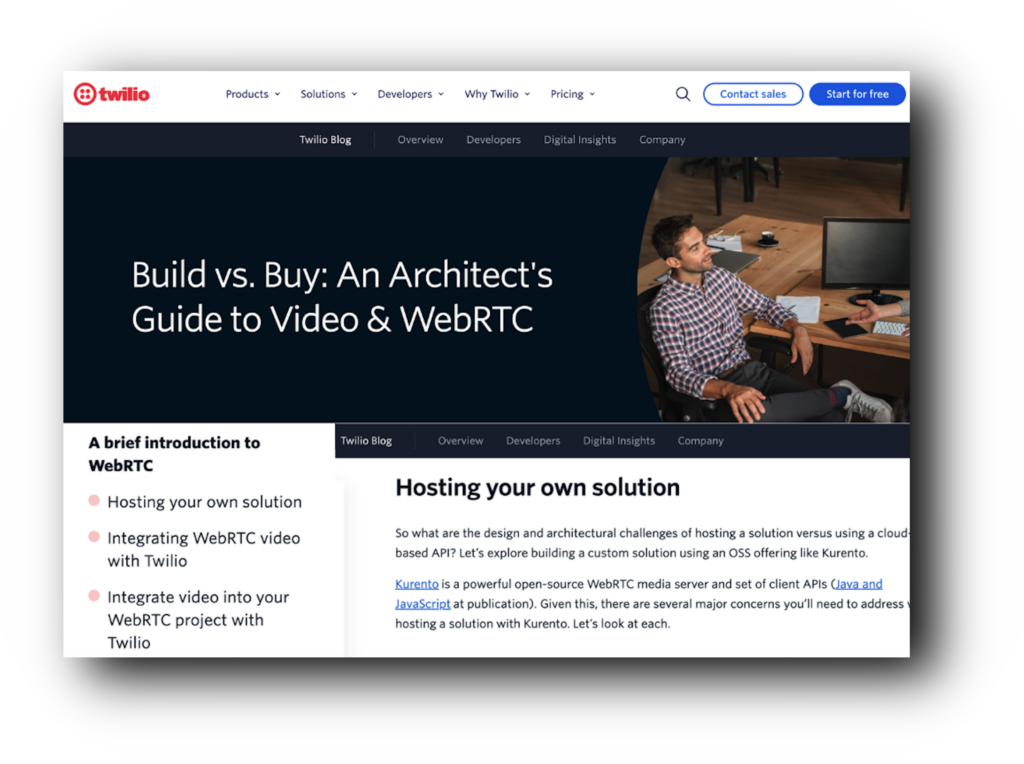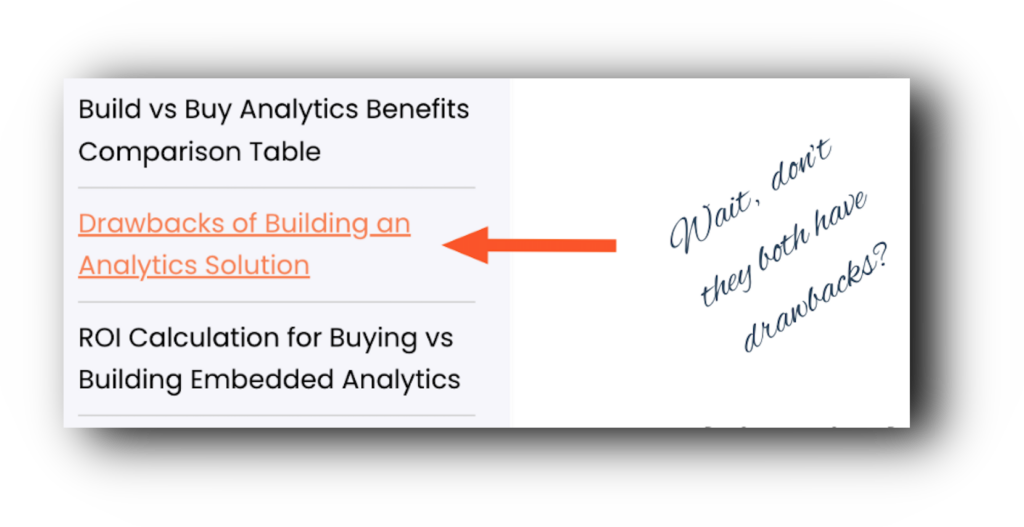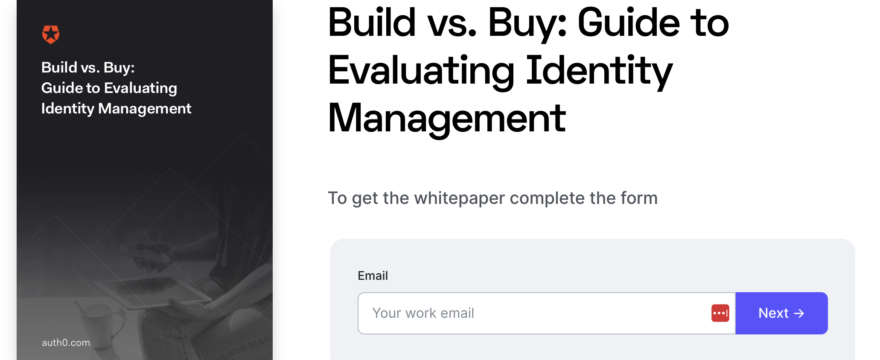Developers don’t spend their entire day writing code. There’s a lot of collaboration, planning, and research. During this time, you hope to capture their attention with your technical content.
A key moment of planning is whether to develop a solution in-house or integrate a pre-packaged product. That’s led to the “build vs buy” guide, which is popular with marketers, but not necessarily developers. Most build vs buy content is a sales pitch for your product, which rarely matches the developer point of view.
When your aim is to promote your product, your biggest competitor is likely developers constructing an alternative themselves. In fact, they may begin their research thinking that’s the only option.
Consider Drew, a senior developer in research mode. In addition to feature requirements for a new project, they have industry compliance needs and some enterprise expectations. Your sales team would love to get Drew on their line, but first, you need to get their attention. And gain their trust.
Let’s take a look at the common issues Drew and other developers face when they find your build vs buy guide. Then let’s see how you can ensure your approach avoids the mistakes, so developers can solve their problem and maybe even trust you to do it for them.
Devs Already Know How This Story Ends
Very few projects are completely brand new, and there’s an abundance of existing research to review. Why not try to learn from fellow devs? All Drew has to do first is wade through marketing fluff that pretends to be educational.
The first site Drew finds seems promising. The company uses the right words, and Drew’s skepticism starts to fade. But then, they hit a form asking for way too much information. Full name, job title, “work email,” and… phone number?! Drew reluctantly fills out the form using a burner Gmail account, leaving optional fields blank.
Once fading, that skepticism is now running high. All to receive a “build vs buy” PDF that could have been a webpage. This no longer looks like educational material — it looks like marketing.

Drew’s experience is fictitious, but it could easily be this gated Auth0 page. Though the company has a great history with developers, they’ve gone a little more enterprise under Okta’s ownership.
Even calling this a “whitepaper” might give developers some pause. The PDF on the other side is neither academic nor deeply technical. It’s a biased argument for buying what the company is selling. Not much “versus” in play here, as they start from the assumption that you want to “move from DIY.”
A better approach would acknowledge that both building and buying have legitimate use cases. Companies could provide transparent analysis without gating content, presenting the full range of considerations for both options.
In software engineering, the answer is always “it depends.” Yet, the typical journey of a build vs buy guide is predictable because the conclusion has been predetermined by the company that wrote it.
For your build vs buy guide to create trust and reduce skepticism with a technical audience, try this:
- Ditch the bias: Present a balanced analysis that respects both build and buy options.
- Be honest about your angle: Don’t try to disguise your sales and marketing as education.
- Avoid gating content: Make educational content freely accessible without forms.
When your guide’s conclusion is skewed towards your product from the start, you’re not educating developers — you’re just making them navigate an obstacle course to reach your sales pitch.
Back to Drew’s research, they quickly confirm there’s little to learn from this first guide. They start to wonder when their phone will ring and how many times they’ll need to click “unsubscribe” before resorting to spam reports. Meanwhile, they’ll move on to the next level of research and hope they find a guide that presents a real comparison.
Devs Want You to Take the Build Option Seriously
Drew loves building. Software engineering is about crafting solutions to complex problems, seeing edge cases in advance, and refactoring around the issues you missed. The reality is that when you buy a solution, you miss all of that fun.
Of course, there are often good reasons to build. In Drew’s case, they have compliance realities to overcome. Luckily, their team has the expertise and a track record of delivering. Most build vs buy content glosses over the build part to focus on the sales pitch for buying. It disregards the team’s talent and presents inflated cost figures, with limited technical details.
Build vs. buy guides miss a basic truth — developers love to create solutions. Building isn’t just about features. It’s about craft, learning, and making something that fits the organization’s exact needs. When guides warn against building with big cost estimates, they attack more than a choice. They dismiss what makes developers who they are.
The choice to build isn’t just about money, either. Teams ask if a project helps them learn new skills. They wonder if it cuts risky dependencies. They value control over key systems. Not everything is dollars and development hours. Average build vs buy guides ignore real non-financial factors in build decisions. As a result, most misunderstand developer motivations.

Even those beloved by developers can go astray. Twilio bought ads on billboards that only say, “Ask Your Developer.” The company is well known for its developer focus. At a glance, you’d think Twilio’s build vs buy guide checks the technical boxes. The very first section is titled “Hosting your own solution.”
But let’s take a closer look at what they included.
There are four short subsections and one architecture diagram. It’s a fine overview, but it doesn’t take the build option very seriously. After cursory coverage, they go deep on exactly how to use Twilio’s product. While volume isn’t everything, these stats still tell a tale.
| Option | Words | Code Blocks | Lines of Code |
| Build | 481 | 0 | 0 |
| Buy | 959 | 5 | 71 |
A better approach would respect developers enough to actually explore building. Companies should share architectural insights, implementation challenges, and solution patterns — not just marketing talking points. When you take building seriously, you show developers you respect their technical judgment.
The most trustworthy guides demonstrate real engineering empathy. You want to provide the technical details to fully evaluate what it would take to build. Developers will remember who treats them as technical equals and who only sees them as potential customers.
For your build vs buy guide to earn developer trust, try this:
- Offer a balanced view: Give equal technical depth to both paths, not just the “buy” option.
- Get hands-on: Show real code for the tough parts of the “build” path.
- Share your resources: Provide tools for builders, even if they don’t buy now.
When your build vs buy guide treats building as a serious option, you show you understand developers. You’ll earn the trust they’ll need to consider buying.
At this point, Drew has found a few guides that actually address building seriously. But even these more technical comparisons rarely discuss limitations. To make a decision, Drew needs to understand the genuine pros and cons of each option, not just the sales pitch.
Devs Want You to Share the Real Trade-offs
During research, Drew spots a pattern — vendors show their products as perfect. But it’s a different story in developer forums. Other devs complain about issues the companies never mention. The “drop-in solution” now seems to need custom code everywhere. To Drew, it feels like these companies are highlighting benefits while hiding limitations.
This isn’t just Drew’s problem. Developers everywhere face the frustration of discovering problems only after committing to a solution. What looks great in a demo often falls short when implemented in complex, real-world systems. Developers want the honest trade-offs that their peers might share over coffee at a technical conference.
When developers discover these hidden limitations on their own, it destroys trust. Every technical solution has trade-offs beyond price. Your APIs will have latency. Your plugin ecosystem can’t match a custom-built system. Yet most guides pretend these limitations don’t exist. Why?

This guide from Qrvey shows exactly what developers find frustrating. The table of contents dedicates an entire section to “Drawbacks of Building an Analytics Solution,” but has no section about buying drawbacks. The message is clear — building has problems, buying doesn’t.
Developers immediately notice this one-sided analysis. With phrases like “building isn’t all rainbows and unicorns,” the anti-build bias is obvious. What could have been educational content instead reveals itself as just another sales pitch in disguise.
A better approach would admit that every solution has limits. Be upfront about them. Show where your product struggles, what integration issues might arise, and when your tool might not be the best fit.
Honest guides build trust by preparing developers for the real work ahead. Share common workarounds and set clear expectations about performance. When developers hit limits, they’ll be ready, not shocked. This turns potential deal-breakers into known challenges they can manage.
For your build vs buy guide to present trade-offs honestly, try this:
- When are they better off building? Identify specific use cases where your product isn’t the ideal choice.
- Where does your product not fit? Share the environmental or technological limitations of your product.
- When does your product stop being out-of-the-box? Show what customization is required beyond the “happy path” demos.
Developers will find your product’s weaknesses anyway. When you point them out first, you build trust that leads to long-term relationships.
Back to Drew’s search for honest information. After seeing too many one-sided guides, they check developer forums for real experiences. There, Drew finds complaints but also praise for a few companies with unusually transparent docs. With new hope, Drew clicks a link to a guide that might finally understand different developer needs.
Devs Think You Should Consider EveryDeveloper
Drew finally finds a build vs buy guide that feels different. This one respects developers’ diverse needs. It shows options for teams of all sizes and different tech stacks. It even admits when building makes more sense than buying. For the first time, Drew feels respected instead of targeted by sales tactics.
Developers like Drew need resources that acknowledge their expertise and provide honest guidance. That’s why EveryDeveloper helps companies see their products from a developer’s perspective, then creates technical content that presents balanced views and acknowledges real trade-offs. Our approach builds trust first, knowing that’s what truly drives developer decisions.
Ready to build developer trust with your technical content? See how you can partner with EveryDeveloper to help your company connect authentically with technical audiences.
